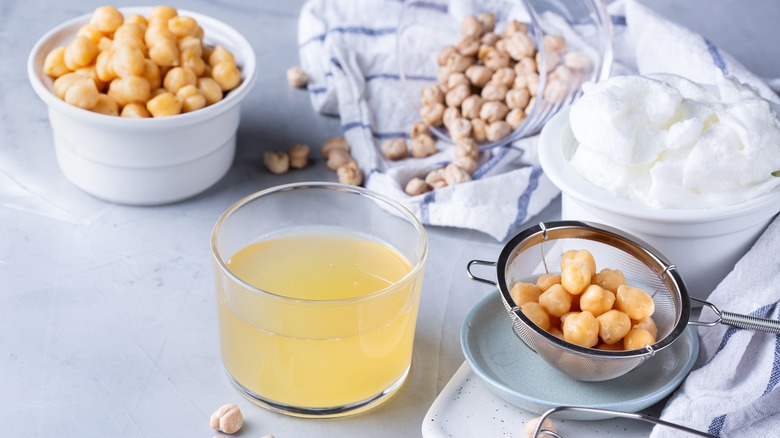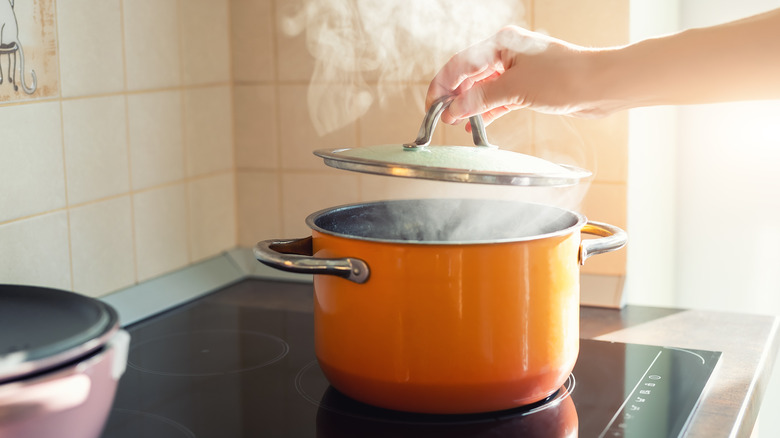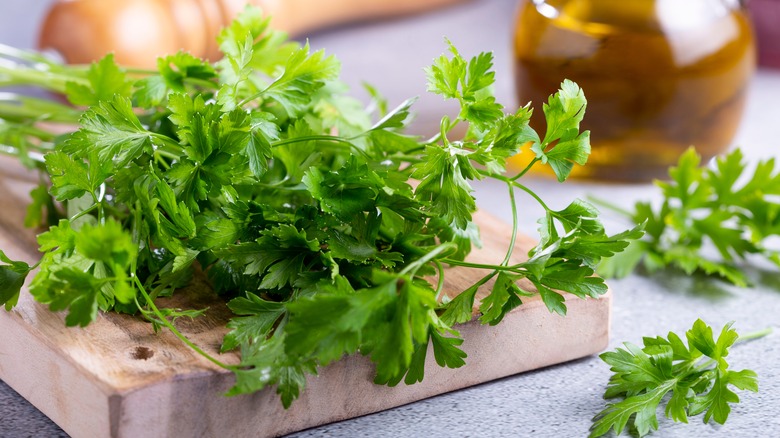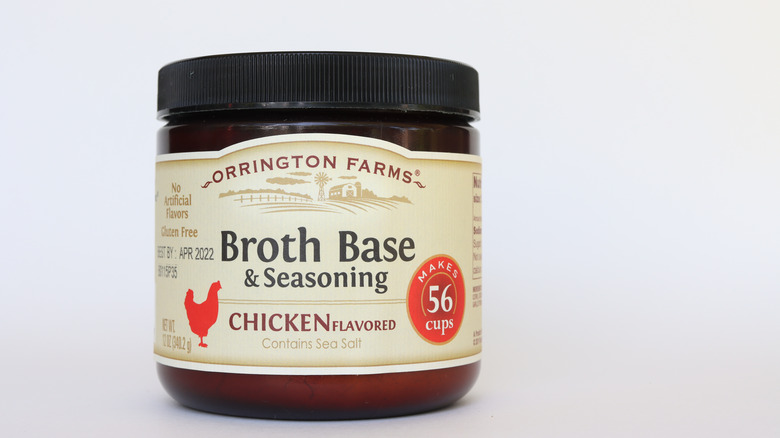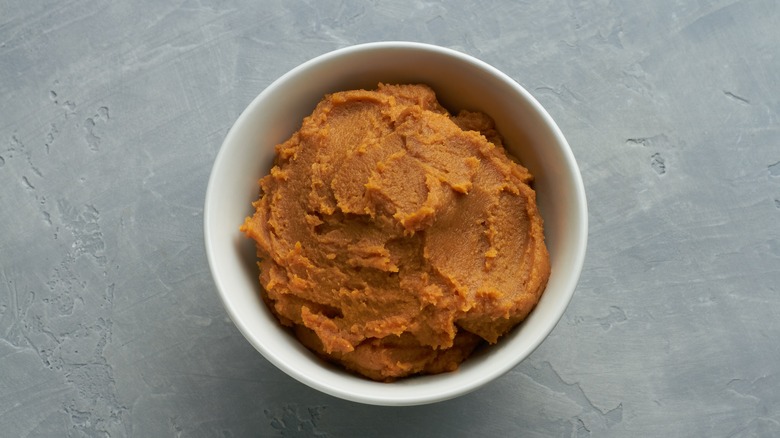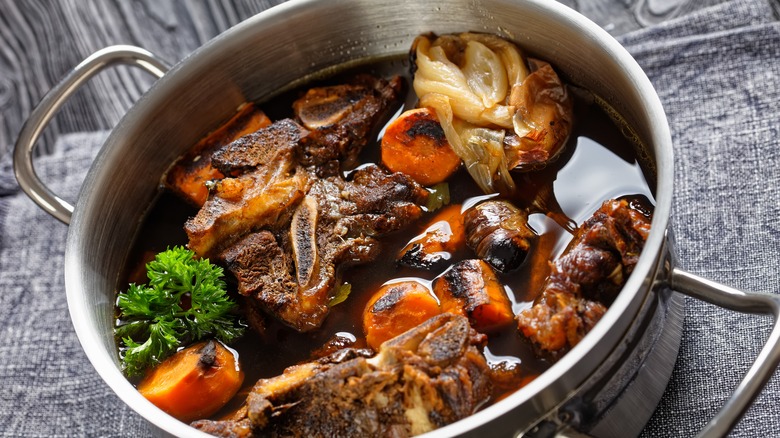The 15 Absolute Best Chicken Broth Substitutes
Chicken broth is a full-bodied, flavor-rich liquid used in many different cuisines across the world. Outside of its flavor profile, consuming chicken broth regularly also has numerous positive health benefits. According to the Cleveland Clinic, chicken broth is rich in collagen which is a vital protein in the body for building bones, tendons, and skin. While eating collagen-rich food doesn't exactly translate to absorbing collagen in the body, this amino acid is vital in the formation of proteins that help the body's proteins in other ways.
Chicken broth is a mainstay for chicken-based soups including chicken noodle, chicken and gnocchi, and chicken and rice. The broth can also help bring flavor and body to sauces and reductions. But if you forget to pick up a box at your local grocery store, don't worry — you don't have to abandon your dinner plans for takeout. There are many simple, inexpensive substitutes for chicken broth right in your cabinets or kitchen.
Chicken stock
Stock and broth — what's the difference? Broth relies primarily on cooking meat for long periods of time with water, vegetables, and herbs. Stock is usually made with bones, vegetables, and herbs. The stock takes significantly more time to cook and develops a more intense, pungent flavor. You can also identify stock by its viscous consistency from the collagen being released from the bones as it cooks. Stock is considered a healthier alternative to broth because it contains more protein and typically less sodium.
You can substitute chicken stock for chicken broth using a 1:1 ratio. While you can purchase stock at your local grocery store, you can also opt to make it at home with a few simple leftover ingredients and your instant pot. Instant pot chicken stock is the perfect way to use leftover bones from a rotisserie chicken. Add your own flavors by slicing in some fennel and leek to the broth while it's cooking.
Bone broth
Per Hungry Huy, bone broth is made similarly to stock. Cooked bones are simmered over low heat for one to two days — however, the slow cooking process releases more gelatin, calcium, collagen, glucosamine, and vitamins than chicken stock. Bone broth can also be purchased from a grocery store or made at home.
We recommend cooking bone broth with unique seasonings like anise, bay leaf, turmeric, and ginger. These spices have known anti-inflammatory properties and are common in many Asian soups and recipes. Plus, the ginger and the turmeric will add a spicy element to the rest of the bone broth without overpowering the traditional chicken flavors.
Bone broth can also be substituted for traditional chicken broth using a 1:1 ratio. If you want a less pungent flavor than what the bone broth provides, dilute it with water. If you do not have chicken bone broth available, you can try to substitute it with beef bone broth instead. Although this substitution might provide an unexpected depth, you lose any chicken flavor you were hoping to impart to your dish. You'll also notice it provides a much darker color than chicken broth.
Chicken bouillon cubes
Bouillon cubes make our cooking lives easier. Home Perch recommends using Knorr's chicken bouillon cubes for soups and stews that call for chicken broth. Knorr's is known as a particularly flavorful bouillon brand made with real parsley and onion. Bouillon is free of genetically modified ingredients and flavored with unique ingredients like lemongrass, ginger, and soy. These magical cubes are a great way to add flavor to rice and are also fantastic for making your own broth when you neglected to pick up a box at the grocery store.
The exact substitution for bouillon cubes will depend on the brand you purchase and the size of the cubes. Typically, bouillon brands recommend dissolving one cube into eight ounces of water to substitute for one cup of broth. If you choose to use bouillon, you should be advised that you may have to alter your recipe to decrease the amount of salt — bouillon cubes are full of sodium and can alter the flavors in your dish if used without care.
White wine
White wine is an essential pantry staple in French cooking, and it can be a valuable asset to a home cook. This alcohol is commonly used to deglaze pans and thicken sauces, but its unique flavor profile can also be used to highlight other ingredients in your dish. We recommend using a splash of dry white wine when the recipe calls for less than ½ cup of chicken broth. If a recipe calls for more than that, you might consider another substitute on this list to avoid dramatically altering the flavors of your dish.
You might be wondering how to select the right kind of cooking wine. If you're cooking with wine, you'll want to aim for a brand that you'd both be willing to drink and that doesn't hurt your wallet. When you cook with wine, many of the flavors from the wine will evaporate and change. Your nice $300 bottle of sauvignon blanc will taste just like a $5 bottom-shelf bottle from your local wine shop after just a few minutes over heat. Leave the nice bottles for drinking with dinner rather than in your dinner.
Salted butter and water
Is there much in the world that butter can't fix? The warm flavors of salty butter can be used as a substitute for a scant amount of chicken broth in a recipe. This means that if your recipe calls for more than about a cup of butter, you should leave the crock in the fridge and find another option. To make a substitute for one cup of chicken broth, mix a cup of water with one tablespoon of salted butter. The Pioneer Woman uses this ratio to impart a fatty flavor without compensating for the liquid needed for a recipe.
Similar to finding the perfect cooking wine, you'll probably want to resort to a cheap butter option for cooking. The best fancy butter brands like Rodolphe Le Meunier and Bordier should be left for spreading on the hot plate of rolls on your table. Instead, use some Vermont Creamery butter — it retails for less than $3 per eight ounces and imparts a delectable salty flavor to your soups and stews.
Aquafaba
Aquafaba is a versatile bean liquid made from draining canned chickpeas. Many vegan baked goods and treats, such as chocolate mousse, use aquafaba as an egg replacement because of its nuanced flavor and leavening properties. According to Beaumont Health, aquafaba is relatively low in calories and comprised of vegetable gum, scant amounts of protein, and starches.
To use aquafaba as a substitute for chicken broth, we recommend first diluting the starchy liquid with equal parts water. The diluted mixture can then be substituted for a 1:1 ratio for chicken broth. Like other substitutes on our list, aquafaba is best used for chicken broth in recipes that do not require a pungent chicken flavor. It is lower in calories than other substitutes on this list (like butter and water) and is a simple swap for a vegan chik'n noodle soup that's the perfect antidote to a cold winter day. If you need a substitute with a pungent chicken flavor, stick with another broth, bouillon, or a concentrate.
Dashi
Dashi is a Japanese broth made with a few simple ingredients: water, kelp (kombu), and dried fish flakes (bonito). This broth is rich in umami and the base for many popular Asian fish soups. When working with dashi, slowly add the solution to the bowl and constantly test for flavor. The fishy undercurrent of the dashi has the tendency to overpower soups and broths, so it isn't always the best replacement for chicken broth — especially when added without careful measuring. If you are using homemade dashi, you can adjust the ratios of kombu and bonito to water to produce a more mild broth that works better as a substitute for chicken broth.
The ingredients for homemade dashi can be purchased from Amazon or your local Asian grocery store. If you'd rather purchase pre-made dashi, we recommend picking up the powdered broth from an online retailer and adding water per package instructions.
Ramen seasoning packets
Ramen noodle seasoning is a salty slew of sodium and spices. But making your own chicken broth with the leftover packets of your TopRamen is an ingenious way to avoid wasting the powdered condiment. Like dashi, the seasoning from the ramen packet is overly concentrated. You'll want to add the packet slowly to a warm cup of water, stirring and tasting along the way.
If you don't want to open individual packets of ramen to extract the coveted seasoning packet, fear not. You can purchase several ounces of chicken-flavored seasoning from Amazon and scoop it into a recipe as needed. Besides making chicken broth, you can use ramen seasoning packets to add a new twist to hot, salty popcorn or roasted potatoes. You can also sprinkle the seasoning on a bit of rice for extra umami flavor, or add it to breadcrumbs for baked chicken. Who knew a college novelty could be so versatile?
Vegetable broth
Vegetable broth can be found in the same aisle of your grocery store as chicken broth or it can be made with vegetable scraps in your fridge. To make your own vegetable broth, simmer leftover vegetables (stems and mushy spots included) in a pot with water. Aromatics like garlic and onion will make your broth more pungent and reminiscent of chicken broth. Dried herbs like parsley, bay leaf, sage, and thyme can also add an aromatic element to your broth that makes it uniquely yours. Your broth will need to cook for about ten minutes before it's strained and stored in your fridge. Although this broth is a good thing to have on hand for emergencies, it won't be as thick as chicken broth or store-bought vegetable broth. Substitute 1:1 into a recipe that calls for chicken stock.
You can also make vegetable broth with mushrooms by cooking dried shiitakes and simmering them with garlic, onion, and fresh herbs. You'll get a punch of umami and the warmth of a plant-based, bone-broth-like beverage.
Coconut milk
Coconut milk is a much fattier chicken broth substitute than other suggestions on this list. Substituting coconut milk is most effective for curries and sauces — especially recipes rooted in Indian and Asian flavors. Coconut milk can also be an effective substitute for chicken broth in a Thai soup and adds a creamier texture to stir fry. It also comes to the aid of arborio rice in a risotto — the coconut milk provides a flavorful and fatty element that can easily complement shredded cheese or butter along with savory flavors like garlic and onion.
When substituting coconut milk for chicken broth, it is important to remember that the fattiness of the coconut milk will alter the flavors and textures of the soup. Clear chicken noodle soup won't be clear anymore, and you'll still need another element to add that savory chicken flavor to the soup.
Herbed water
Many recipes call for chicken broth as a way to add bulk. One of the simplest ways to amp up the flavor (and bulk) of a dish is to simmer herbs in water and add the warm liquid to the rest of your ingredients. Salt the water as needed to complement the other flavors being used.
The spices you choose to use will depend on the recipe. Italian or French recipes that call for chicken broth can typically benefit from the fresh flavor of parsley, bay leaf, thyme, sage, or oregano. If you're making an Asian or Indian recipe, you might resort to lemongrass and green onions. You can also think out of the box: Upgrade your chicken noodle soup by adding gremolata — a mix of lemon zest, Italian parsley, and garlic.
Although using fresh herbs can provide a more organic flavor to your dish, dried herbs are usually a cheaper option. If you are an avid gardener, consider freezing your herbs from the summer in small bags to add to recipes as needed.
Chicken broth concentrate
Broth concentrate is one ingredient we always have in our pantry. It's usually made from the same ingredients as bouillon cubes but with a gum- or paste-like ingredient that makes the concentrate spoonable. You'll want to mix the ratio of concentrate to water according to the package directions before adding the mixture to your dish.
In a review of popular chicken bouillon concentrate brands, Fine Cooking found the most favorable results from Better Than Bouillon and Swanson Flavor Boost. Better Than Bouillon proved to be the cheapest per-cup option at around $0.16 per cup of broth. Reviewers found this broth to be salty, so folks who choose to use it should taste it prior to adding more salt to the recipe. Swanson Flavor Boost provided the best meaty flavor with the lowest sodium amount but cost significantly more at around $0.51 per cup. The brand you choose will likely be based on personal preference and availability in your region.
Miso
According to an article in the Chicago Tribune, miso is a versatile, umami-rich paste made from inoculated soybeans called koji. The paste varies in color based on the fermentation time — generally, the darkest miso types have the most profound flavor profiles. Since miso is very dense and flavorful, it can be blended into water to dilute the salty taste. If substituting miso paste for chicken broth, we recommend adding miso paste to taste and pouring in a proportional amount of water to bulk up the recipe. Additionally, you should avoid adding miso to high heat to preserve its nutritional value. Therefore, miso should be added towards the end of the cooking process, if possible.
Miso's chemical makeup allows the paste to have an extensive shelf life. You can purchase a large tub of miso (or individual small packets) from your local grocery store and leave it in your fridge for a few months until you're ready to use it.
Plain tap water
You should have this ingredient in your kitchen — it's just plain water! You can add bulk to your soups and sauces without disrupting the flavor when you use water in lieu of broth. When you add water to a soup, you may dilute some of the seasonings, so add salt to your dish as needed to amplify the taste and flavors. You'll also want to heat up the water before you add it to your recipe as adding cold water will alter the cooking times and potentially have a drastic impact on the dish. Use a microwave-safe measuring cup to heat up your water before adding it in.
If water can be substituted for broth, can broth be substituted for water? The answer is yes — most of the time. Soups and sauces that list water as an ingredient can benefit from the umami punch of chicken broth. Always taste the recipe before adding excess salt if using chicken broth instead of water.
Beef broth
Beef broth carries a darker flavor and color than chicken broth, however, they both contain collagen — thus making the chemical background of these two broths very similar. You can substitute chicken and beef broth interchangeably in recipes using a 1:1 ratio.
Beef broth is usually found in the same grocery aisle as chicken broth but may carry a bit of a higher price tag than its poultry counterpart. You can also make beef broth at home by combing a mirepoix of carrots, celery, and onions with beef bones. You can also add many of the same spices commonly used with chicken broth like parsley, thyme, and bay leaf. Allow the broth to simmer for a few hours before straining and storing it in an air-tight container in your refrigerator. That way, you'll have beef broth whenever you get around to making a French onion soup or forget to pick up a box of chicken broth at the store.






